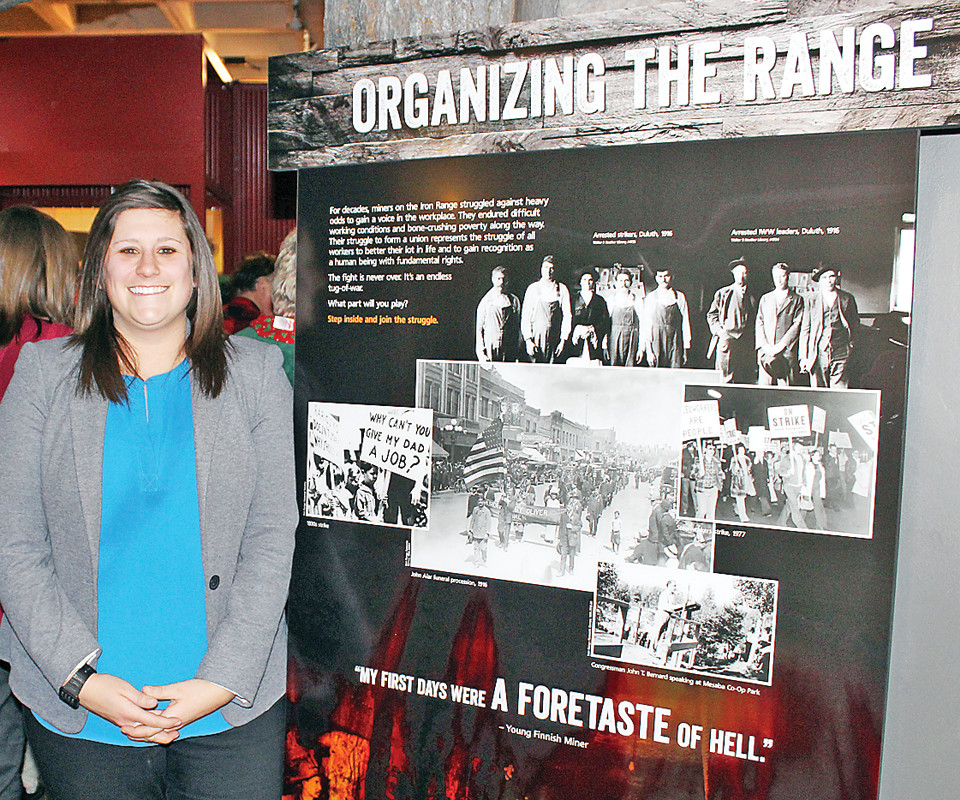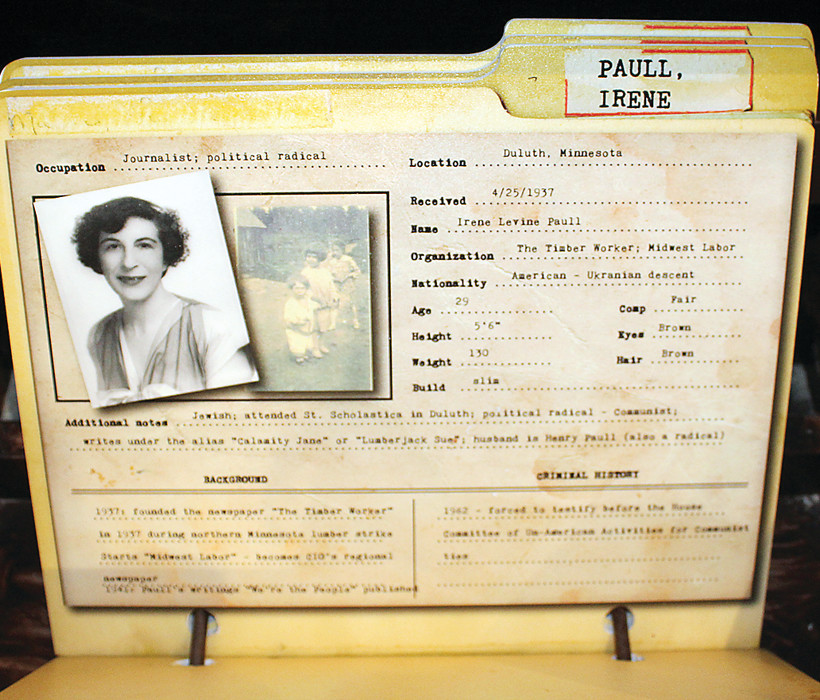Support the Timberjay by making a donation.
Telling our stories
Discovery Center’s newest exhibit focuses on history of Iron Range labor
CHISHOLM- The newest permanent exhibit at the Minnesota Discovery Center is a journey into the labor history of the Iron Range, highlighting struggles that had national significance.
The public …
This item is available in full to subscribers.
Attention subscribers
To continue reading, you will need to either log in to your subscriber account, or purchase a new subscription.
If you are a current print subscriber, you can set up a free website account and connect your subscription to it by clicking here.
If you are a digital subscriber with an active, online-only subscription then you already have an account here. Just reset your password if you've not yet logged in to your account on this new site.
Otherwise, click here to view your options for subscribing.
Please log in to continue |
Telling our stories
Discovery Center’s newest exhibit focuses on history of Iron Range labor
CHISHOLM- The newest permanent exhibit at the Minnesota Discovery Center is a journey into the labor history of the Iron Range, highlighting struggles that had national significance.
The public got their first look at “Blue Collar Battleground: The Iron Range Labor Story” at a grand opening celebration on Dec. 7. Iron Range Historian Pam Brunfelt opened the evening with a talk about how Iron Range miners, from the Cuyuna, Mesaba, and Vermilion iron ranges fought to get safer working conditions and economic justice.
MDC Curator Allyse Freeman said the impetus for the exhibit, a three-year journey, started with the exhibit “Enough! 1916 Mesabi Range Strike.” The new exhibit built and expanded on this piece of labor history, moving forward through the next 100 years.
The exhibit is part of the transformation of MDC into a nationally-recognized history museum. The “Enough” exhibit won national recognition as well as statewide awards for its telling of the turbulent early days of the Iron Range miners.
“Labor history is not often covered in textbooks,” Freeman said. “But labor history is part of the Iron Range’s roots”
The exhibit was funded with a $90,000 legacy grant from the Minnesota Historical Society, along with matching funds from MDC and the IRRRB.
“I am so proud of what this place [MDC] has become,” said Brunfelt. “Their tagline is now the “Museum of the Iron Range,” and it has been an amazing transformation. Brunfelt urged the audience, which mostly filled the auditorium, to consider becoming members, and help to support the important work being done by MDC staff, archivists, educators, and historians.
“This whole story is about the struggle of poor immigrants to be treated as human beings,” Brunfelt said. “It was intense, dangerous, and ugly. They took the chance to push for justice.”
Brunfelt noted that many of these immigrants lost their jobs in the mines after advocating for better working conditions. Her grandfather was among these pioneers. After losing his job, he took up farming, and struggled to make a living for his family.
“This was a battleground for justice,” she said.
Freeman said the work she has done the past three years has ignited what she knows will be a lifelong interest in labor history. She started at MDC in 2014, after earning her masters degree from the University of Wisconsin, Milwaukee, in Museum Studies and Anthropology.
“I knew they were about to begin a major renovation,” she said, “but didn’t know the focus was labor history.”
The topic proved to be more than enough to create what will become a centerpiece of the history center. The exhibit starts out with a look at the early days of the dangerous work of underground mining. Visitors enter a darkened cavern, and watch as miners blast out rock. The 1916 strike, well-covered in the previous temporary exhibit, is mentioned but is only a piece of the new exhibit, with the red flag, from a parade in Hibbing, as a reminder.
Brunfelt gave the audience a brief overview of the significant turning points in labor history, from the many failed attempts at unionization starting in 1902, to the government backing of the corporations.
“How clueless the elites were,” Brunfelt said. “They had no idea about the life of these immigrant miners.”
Brunfelt said the support of women made a huge impact during strike activities in the 1910s.
With 43 nationalities of workers in the mines, the corporate owners felt this would stop any effort at unionization, she said. But the solidarity of the workers coalesced during these hard times, and the immigrant groups began to establish a common dialect and culture.
“This was the first step to becoming Rangers,” she said. “Workers learned to speak a common language.”
“The Slavs hated each other in Europe but came here and worked together,” she said.
Mine owners resorted to spies and violence to keep workers under control. Brunfelt talked about discovering original documents which showed how the mine owners hired prisoners from the jail in Duluth to provide “protection” at the mines.
“These prisoners were deputized,” she said.
World War I, and the effort to draft immigrants, was a key to radicalizing the area’s labor force.
“There was massive resistance by immigrants to the draft,” she said, noting that these workers, many of whom did not speak English, didn’t understand notices that were mailed to them.
“They were rounded up in ‘slacker drives’ and sentenced to prison,” she said. At the same time, the government cracked down on the Industrial Workers of the World (IWW), and actually burned almost all of the union’s records. There are only a few original records that remain, including some pieces now part of the exhibit.
In Minnesota, there was a state commission on public safety that spied on mine workers. The exhibit includes some of the dossiers compiled, including those of ordinary residents as well as some of the area’s more illustrious communists.
“Between 1906 and 1916 over 700 died in the mines,” she said. “Working conditions were awful, and pay was 33 cents per hour in 1910.”
During the Great Depression, the mines basically shut down because there was no demand for steel.
“This is when the area became radicalized,” she said
The era of the New Deal changed the calculus of corporate versus labor relations for the better. For the first time, she said, the federal government came down on the side of the workers, and by the mid- 1930s, the National Labor Relations Act was passed and the labor movement took off.
The start of World War II, and the importance of the iron mines to the war effort, led to the signing of the first union contracts in 1943.
“The War Production Board ordered the companies to sign a contract with their men,” she said. “They went from dirt poor to middle class.”
The new exhibit also highlights other union efforts on the Range, including the American Linen workers strike and the efforts of female employees at the Eveleth Taconite Company (described in the book “Class Action”) in the 1980s, a case where the union did not side with their workers.
“This is a dark spot in our labor history,” she said.
“This is the most unionized area in Minnesota,” she said, “and possibly in the Midwest.”
This journey through labor history joins the other permanent exhibits at MDC, including The Emigrant Journey, Civilian Conservation Corps History, Iron Range Schools, Hall of Geology, Peerless Auto, Rag Rugs, Saloon, The First Minnesotans, The Fur Trade Era, Gov. Rudy Perpich, Underground Minings, and The Ojibwe Seasonal Cycle. MDC also features a working trolley (that operates in the summer), and a mini-golf course. The outdoor amphitheater hosts many cultural and musical performances in the summer.
The Minnesota Discovery Center
Through the generous support of our members, donors, volunteers and sponsors, Minnesota Discovery Center in Chisholm advances its mission to promote the understanding and exploration of Minnesota culture and history:
Enhancing lives of the people in our community through events, programs and exhibits.
Offering relevant exhibitions and educational programs as an active partner in the STEM movement.
Showcasing the heritage and treasures of the Iron Range to a worldwide audience.
The museum and archives are open year- round. Winter hours are Tuesday through Saturday from 10 a.m. – 5 p.m., with extended hours on Thursday evening, open until 8 p.m. MDC is closed Sunday and Monday during the winter. Admission is $9 for adults, $8 for seniors/military, and $5 for students. Admission is free on Thursdays from 3 p.m. – 8 p.m.
MDC offers many educational events for all ages; see their website for details: www.mndiscoverycenter.com.
Minnesota Discovery Center is a nonprofit institution and the state’s largest museum complex outside of the Twin Cities metro area.
Dig into the past with one of the largest collections of genealogical and local history research materials in the Upper Midwest.
There is no admission charge to visit the Iron Range Research Center. Access to certain archival collections does require assistance from the Archivist on staff, so please call ahead or contact us by email to schedule an appointment.









